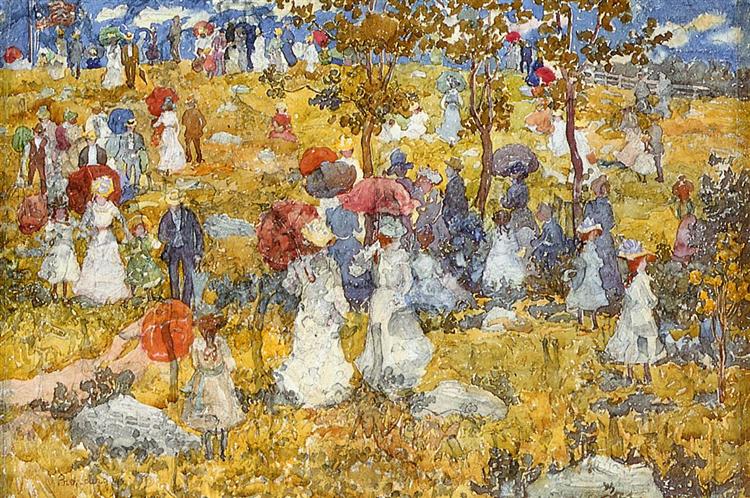Description
The work "In the Park" (1897) by Maurice Prendergast is a fascinating representation of the post -impressionist style that characterizes much of his work. The scene evokes an atmosphere of tranquility in which daily life is intertwined with the splendor of nature, a mixture that sets on mastery. In this painting, we can observe a group of people who, disseminated by the environment, seem to enjoy the outdoors and the mutual company, encapsulating the essence of a moment of leisure and collective enjoyment.
The composition of the work is remarkable not only for the use of space, but also for its perspective. The characters, although not strictly defined, are an integral part of the landscape. His positions create a flow that guides the viewer's gaze through the scene, causing each figure to contribute to the general narrative without dominating it. The disposition of the figures offers us a sense of community, reflecting a daily life that invites contemplation.
The use of color in "in the park" is particularly prominent. Purkey opts for a vibrant and luminous palette, using warm tones that evoke daylight. The green of the grass and the trees, combined with the brilliant women's dresses, generate a visual contrast that enhances the sensation of vitality and freshness. The technique of loose brushstrokes, typical of post -impressionism, adds an interesting texture to the work, suggesting movement and life in each fast touch of color.
The characters that populated the canvas are not portrayed individually, allowing each spectator to interpret the painting from their own perspective. This quality aligns with the general approach of the work of Prendentgast, where the human figure is not placed in the center of attention, but becomes part of a broader whole. The diversity of postures and attitudes between the characters suggests the variety of experiences that can be found in a public environment like a park.
Regarding the artistic context, Maurice Prentergast was a prominent member of the American Masters movement, and his work was influenced by various currents, including French impressionists and Japanese art. The fusion of elements of these styles, along with their enthusiasm for color and form, resulted in works that transmit a sense of joy and luminosity.
"In the park" it can be seen as a reflection of the urban life of the late nineteenth century in the United States, a period of change and modernity. The work closes a window to a world where nature and society interact in harmony. In the context of its production, this painting is a paradigmatic example of the ability to turn on to capture the essence of a moment, using the color and composition to invite the viewer to immerse themselves in the recreational environment of the park. Thus, when contemplating "in the park", we are not only witnesses of a scene, but we also participate in the celebration of life itself.
KUADROS ©, a famous paint on your wall.
Hand-made oil painting reproductions, with the quality of professional artists and the distinctive seal of KUADROS ©.
Art reproduction service with satisfaction guarantee. If you are not completely satisfied with the replica of your painting, we refund your money 100%.

